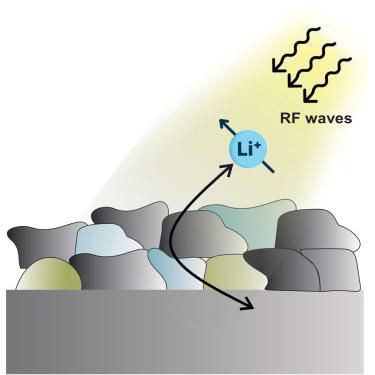Joule ( IF 38.6 ) Pub Date : 2024-05-20 , DOI: 10.1016/j.joule.2024.04.016 Asya Svirinovsky-Arbeli , Mikkel Juelsholt , Richard May , Yongbeom Kwon , Lauren E. Marbella

|
The performance of Li metal batteries is tightly coupled to the composition and properties of the solid electrolyte interphase (SEI). Even though the role of the SEI in battery function is well understood (e.g., it must be electronically insulating and ionically conductive, it must enable uniform Li+ flux to the electrode to prevent filament growth, it must accommodate the large volume changes of Li electrodeposition), the challenges associated with probing this delicate composite layer have hindered the development of Li metal batteries for practical applications. In this review, we detail how nuclear magnetic resonance (NMR) spectroscopy can help bridge this gap in characterization due to its unique ability to describe local structure (e.g., changes in crystallite size and amorphous species in the SEI) in conjunction with ion dynamics while connecting these properties to electrochemical behavior. By leveraging NMR, we can gain molecular-level insight to aid in the design of Li surfaces and enable reactive anodes for next-generation, high-energy-density batteries.
中文翻译:

使用核磁共振波谱将结构与锂固体电解质界面的功能联系起来
锂金属电池的性能与固体电解质中间相(SEI)的成分和性能紧密相关。尽管 SEI 在电池功能中的作用众所周知(例如,它必须是电子绝缘的和离子导电的,它必须使 Li + 通量均匀地流向电极以防止灯丝生长,它必须适应锂电沉积的巨大体积变化),探测这种精致的复合层所面临的挑战阻碍了锂金属电池实际应用的发展。在这篇综述中,我们详细介绍了核磁共振 (NMR) 光谱如何帮助弥合表征方面的这一差距,因为它具有描述局部结构(例如,SEI 中微晶尺寸和无定形物质的变化)的独特能力,同时结合离子动力学,同时将这些特性与电化学行为联系起来。通过利用核磁共振,我们可以获得分子水平的洞察力,以帮助设计锂表面,并为下一代高能量密度电池提供反应性阳极。











































 京公网安备 11010802027423号
京公网安备 11010802027423号